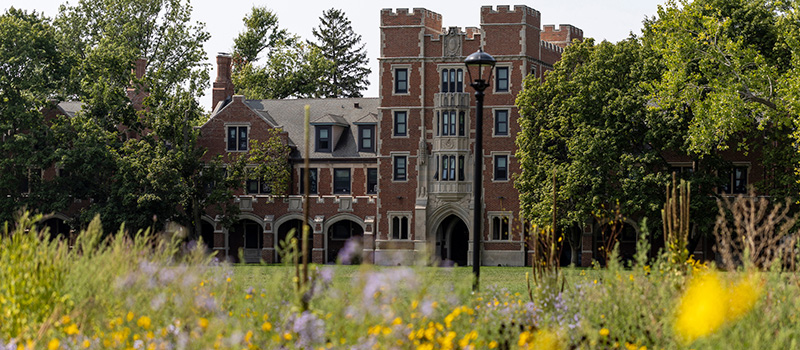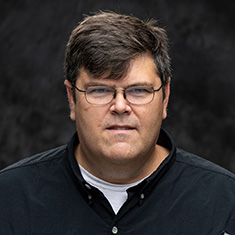Green Fund helps grow sustainability projects on campus
August 22, 2024 — During the past two years, Grace Kurtz ’25 has measured energy consumption, re-wrote sections of Grinnell’s sustainability plan, researched the carbon footprint for off-campus travel, weeded on-campus prairies, and created environmentally themed educational materials.
As far as campus jobs go, being a student coordinator in the Grinnell College Office of Sustainability has been incredibly impactful and rewarding.
“I’m really enjoying getting to contribute to sustainability on campus and in the community,” Kurtz says. “I’ve always been interested in sustainability, and my grandma is an environmental activist. When I first came here, I thought it would be more like watching people conduct projects, so it’s been really exciting to have a hands-on approach and be a part of the sustainability movement.”
 In May 2022, about two dozen Grinnell students spent two days prairie planting on North Campus.
In May 2022, about two dozen Grinnell students spent two days prairie planting on North Campus.
Thanks to alumni donations to the Green Fund, student coordinators has been a paid position at the College over the last several years. The coordinators have completed dozens of green projects, many of which were suggested by fellow students.
“I’m really grateful for this job,” Kurtz says. “I’m interested in sustainability on its own. But getting the opportunity to be paid has been amazing. In this job, I’m helping Grinnell with sustainability, but I’m also learning a lot from it. It’s nice that alums are invested in Grinnell being sustainable and helping us outside the classroom. I really value that.”
Class of 1966 gives green for green
Chris Bair ’96, environmental and safety coordinator, has worked at the College for the last 18 years and recalls numerous times students came to him with an environmentally friendly idea. Without designated money, Bair had to either make a budget request for the following year or rely on students to volunteer their time.
In 2016, the class of 1966 was discussing options for a class gift to commemorate its 50th reunion. David Imes ’66 suggested a gift for solar panels, which got the ball rolling to think about green initiatives. Imes’ former roommate, David Miller ’66, initiated conversations with Buddy Boulton, director of planned giving, about some funding options. The most appealing was a Green Initiative Fund to provide funding for environmental related projects proposed by students.
“I said that’s terrific,” Miller recalls. “It’s sustainability, and it would involve education and students. Those were the two main purposes for me. I think it has worked out really well along those lines.”
 The prairie on Mac Field is one of three on campus that student coordinators maintain.
The prairie on Mac Field is one of three on campus that student coordinators maintain.
Miller took the idea back to the 1966 Reunion Class Committee and fundraising began. “It was such a good idea, so it was easy to sell,” Miller says. “I can’t recall any pushback.”
A goal of the fund is to help students become aware of, and contribute to, reducing demands on the natural environment so they can develop a mature vision of personal responsibility, environmental science, and social ethics. Eight years later, Bair said it has succeeded in that intention.
“Anytime you can have students research problems they’ve identified on campus, it’s a huge win,” he says.
A wide range of projects
When Miller returns to the College, one of his favorite activities is to wander around and look at the trees, thinking about the role they have played on campus over the years. “It doesn’t have much to do with clean or solar energy, but the trees connect us to the Iowa landscape and the history of the College,” he says.
For the College’s sesquicentennial celebration in 1996, a map detailing all the campus trees was created. As to be expected, a lot has changed over the last 28 years as new trees were planted and older ones were lost. Students have been updating the map and the revised version should be ready this upcoming school year.
“Working on the tree map at Grinnell has allowed me to develop a better understanding of my surrounding natural environment,” says Sara Garcia ’25, a land steward (one of the student coordinator jobs) last school year. “I spent hours walking all around campus with the other land steward, identifying every tree that we found. I can now walk outside and recognize the trees and living things by name. This has increased my appreciation for the natural Iowa landscape and allowed me to create a deeper personal connection to this ecosystem. I am excited to share this map with other students so that they can experience the same wonder and appreciation of the living things on campus.”
 Student coordinators have been identifying every tree on campus to update a tree map created in the 1990s.
Student coordinators have been identifying every tree on campus to update a tree map created in the 1990s.
Additional projects have dealt with campus recycling, such as recycling container audits and waste sorts to see what recyclable items are ending up in waste baskets. “We pick a building, and then on Friday we open the trash baskets and sort the materials. It can be stinky but fun,” Bair reports.
Other recent projects have been weeding campus prairies, working on a website to make energy consumption data real time and available to students, drafting emissions reports, making promotional videos, assisting with an organic lawn pilot project, clothes mending workshops, clothing swaps, water usage studies, and research into creating a free store on campus.
The Green Fund also supported the purchase of the campus’ first Water Monster Hydration Station, a huge water container that attendees at Commencement and Reunion can use to fill up their own water bottles. “It worked out, so Dining Services bought two more,” Bair says. “It’s been really nice to have these resources to be able to try new things and see if they work.”
 Chris Bair ’96
Chris Bair ’96
About 90 percent of the Green Fund is devoted to the salaries of student coordinators while the remainder supports the students’ project work.
After the new school year gets underway, Bair will meet with this year’s student coordinators to find out what projects they are interested in working on.
“It bodes well that they can pick what they want to work on,” he says. “It gives them experience. It also gives them a behind-the-scenes look at facilities. I think most students doesn’t understand how energy moves around campus and where it comes from.”
Some past coordinators like Sharene Gould Dulabaum ’22 have gone on to work or have internships in the sustainability industry. Kurtz, a political science major, is considering it. But even if students’ careers head in a different direction, they feel more empowered to create a more ecologically vibrant world.
“The skills that I have developed while working as a land steward will continue to be applicable throughout the rest of my life,” Garcia says. “I expect to apply creative thinking to envision new sustainable solutions in every environment that I enter post-graduation.”
— by Jeremy Shapiro